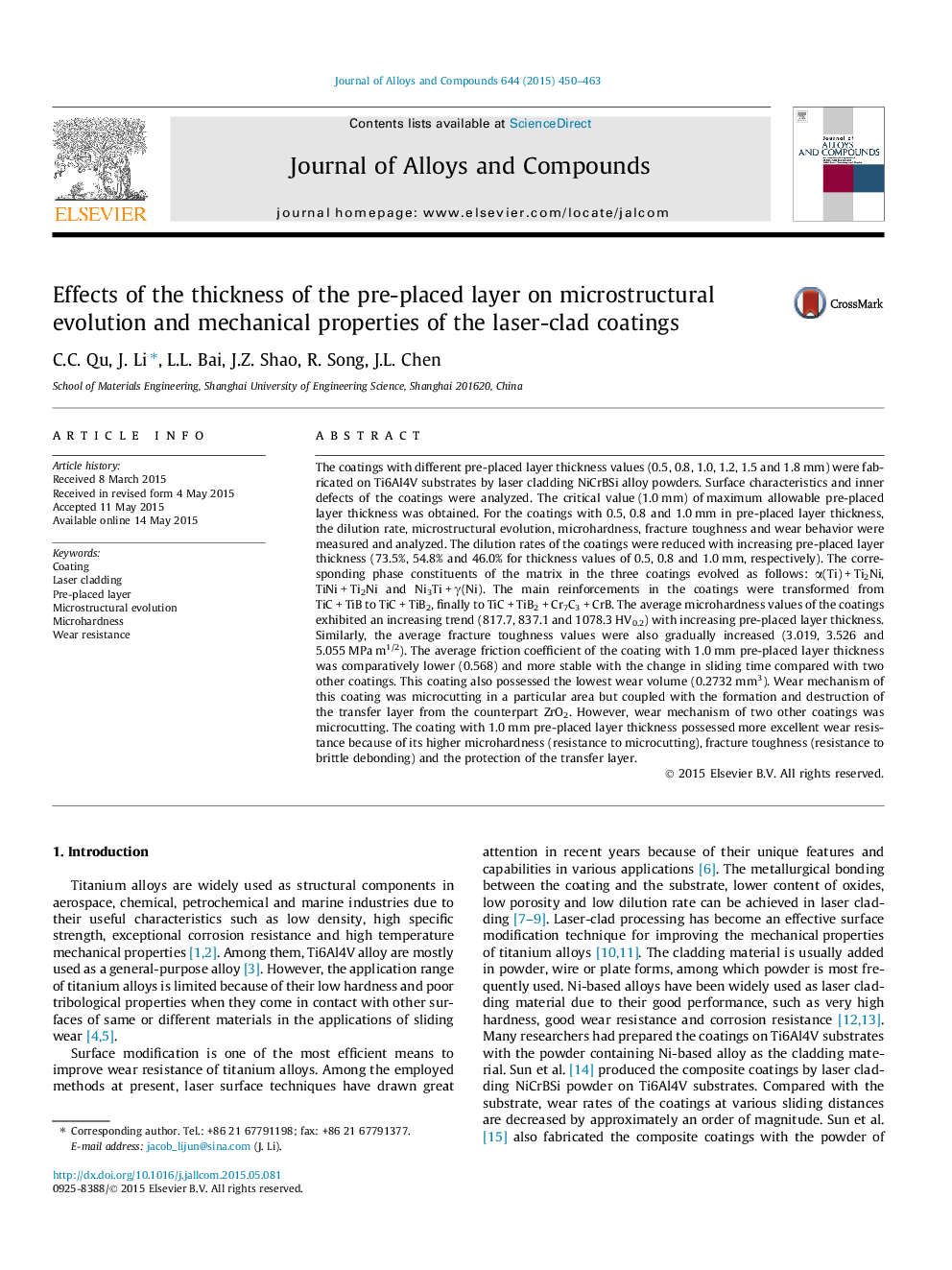| کد مقاله | کد نشریه | سال انتشار | مقاله انگلیسی | نسخه تمام متن |
|---|---|---|---|---|
| 7998565 | 1516249 | 2015 | 14 صفحه PDF | دانلود رایگان |
عنوان انگلیسی مقاله ISI
Effects of the thickness of the pre-placed layer on microstructural evolution and mechanical properties of the laser-clad coatings
ترجمه فارسی عنوان
اثرات ضخامت لایه قبل از قرارگیری بر تکامل میکرو سازنده و خواص مکانیکی پوشش های لایزر پوشش داده شده
دانلود مقاله + سفارش ترجمه
دانلود مقاله ISI انگلیسی
رایگان برای ایرانیان
کلمات کلیدی
پوشش روکش فلزی لیزری، لایه پیش ساخته شده تکامل میکرو سازگار، میکرو سختی، مقاومت در برابر سایش،
موضوعات مرتبط
مهندسی و علوم پایه
مهندسی مواد
فلزات و آلیاژها
چکیده انگلیسی
The coatings with different pre-placed layer thickness values (0.5, 0.8, 1.0, 1.2, 1.5 and 1.8 mm) were fabricated on Ti6Al4V substrates by laser cladding NiCrBSi alloy powders. Surface characteristics and inner defects of the coatings were analyzed. The critical value (1.0 mm) of maximum allowable pre-placed layer thickness was obtained. For the coatings with 0.5, 0.8 and 1.0 mm in pre-placed layer thickness, the dilution rate, microstructural evolution, microhardness, fracture toughness and wear behavior were measured and analyzed. The dilution rates of the coatings were reduced with increasing pre-placed layer thickness (73.5%, 54.8% and 46.0% for thickness values of 0.5, 0.8 and 1.0 mm, respectively). The corresponding phase constituents of the matrix in the three coatings evolved as follows: α(Ti) + Ti2Ni, TiNi + Ti2Ni and Ni3Ti + γ(Ni). The main reinforcements in the coatings were transformed from TiC + TiB to TiC + TiB2, finally to TiC + TiB2 + Cr7C3 + CrB. The average microhardness values of the coatings exhibited an increasing trend (817.7, 837.1 and 1078.3 HV0.2) with increasing pre-placed layer thickness. Similarly, the average fracture toughness values were also gradually increased (3.019, 3.526 and 5.055 MPa m1/2). The average friction coefficient of the coating with 1.0 mm pre-placed layer thickness was comparatively lower (0.568) and more stable with the change in sliding time compared with two other coatings. This coating also possessed the lowest wear volume (0.2732 mm3). Wear mechanism of this coating was microcutting in a particular area but coupled with the formation and destruction of the transfer layer from the counterpart ZrO2. However, wear mechanism of two other coatings was microcutting. The coating with 1.0 mm pre-placed layer thickness possessed more excellent wear resistance because of its higher microhardness (resistance to microcutting), fracture toughness (resistance to brittle debonding) and the protection of the transfer layer.
ناشر
Database: Elsevier - ScienceDirect (ساینس دایرکت)
Journal: Journal of Alloys and Compounds - Volume 644, 25 September 2015, Pages 450-463
Journal: Journal of Alloys and Compounds - Volume 644, 25 September 2015, Pages 450-463
نویسندگان
C.C. Qu, J. Li, L.L. Bai, J.Z. Shao, R. Song, J.L. Chen,
